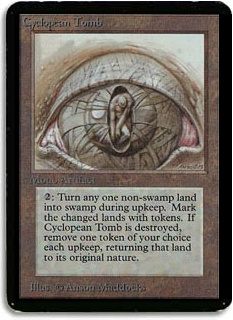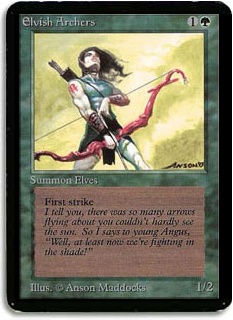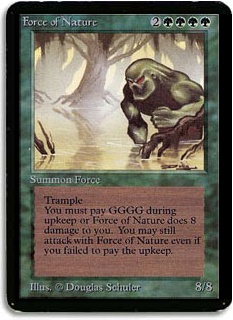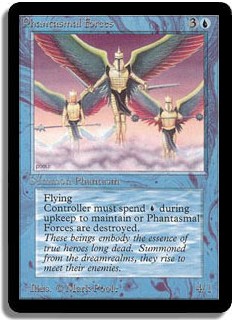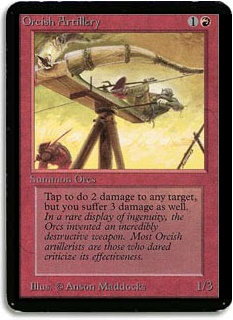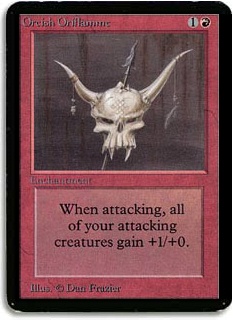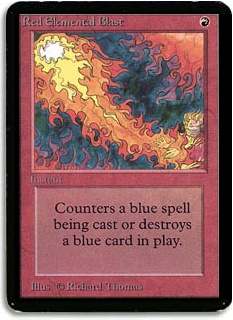Fort Worth, Texas.
July 13, 1993.
On the first day of the Origins International Game Expo, Richard Garfield released Magic: The Gathering into the world. It was designed to be portable enough to be played at conventions like Origins and customizable enough to fit many different play styles. Word of the game’s unique properties spread quickly, and it became the breakout hit of the summer. When cards went on sale to the general public on August 4th, they sold out almost immediately. Everyone who didn’t act immediately had to wait until October, when Beta was released. Of course, that set sold out immediately as well.
Beta and beyond is a story that’s been unfolding for nineteen years and counting. For now, I want to focus exclusively on Magic’s first set.
Let’s talk all about Alpha.
Magic by the Numbers
Alpha contained 295 cards. 116 were rare, 95 were common, 74 were common, and 10 were basic land.
Instead of putting the basic lands on a separate print sheet like they do now, they mixed them in with the other cards. According to Crystal Keep, you had a 3.31% of getting a land as your rare, a 21.5% shot of getting one as an uncommon, and a 38.02% chance of snagging one in a common slot. This meant that you had a 1 in 33 shot of getting a pack with no rare, 3 out of every 5 packs had one as an uncommon, and each pack likely had several lands in place of other commons. Of course, back when there was no other way to get land, very few people minded.
Alpha cards were evenly distributed between starter decks and booster decks. It wasn’t until Unlimited that more cards were put in boosters, and even then a full third of the cards in the expansion were still sold in starters—a product that no longer even exists.
These days, Wizards of the Coast doesn’t publically reveal information about how many copies of each card are printed. While I can tell you that many more packs of Zendikar were manufactured than of Coldsnap, I can’t tell you how big that gap is.
In 1993, though, Richard and his fledgling company were completely transparent about how many copies of each card were produced. We know for a fact that Alpha had a print run of 2.6 million cards. Beta’s run was 7.3 million. There were 40 million Unlimited cards sent to press along with an estimated 500 million Revised cards. That’s a huge chunk of cardboard!
This means that for every Alpha copy of a card printed, there were roughly three Beta copies. It also means that Alpha only accounts for about 5% of the Power 9 print run, making those very first copies astonishingly rare.
The print run for each rare in Alpha was just 1,100. All of the Alpha Black Lotuses to ever exist could fit inside a single longbox.
4,500 of each Alpha uncommon were printed along with 16,000 of each Alpha common and 85,500 of each Alpha land (per picture). While this seems like a lot compared to the number of rares printed, it is still dwarfed by the number of cards printed in every other set. For example, every Alpha common is rarer than, say, an Unlimited Black Lotus—a whopping 18,500 of those were made. Each common in Alpha is 228 times rarer than its Revised Edition counterpart. Â
While it is unclear how many Alpha cards have survived to the present day, it is probable that at least a third of the print run has been lost to time, if not more. How many of these 20-year-old cards were accidentally thrown away? How many had a beer accidentally spilled on them or were drawn on by an unsuspecting kid? How many are still lurking in closets or sitting in stagnant collections?
Don’t forget that Magic wasn’t designed to be a collectable game. The idea of a secondary market for game cards was as unheard of as your Monopoly pieces suddenly being worth hundreds of dollars.
Alpha Variations
It’s very easy to tell the difference between an Alpha card and any other card in Magic.
For starters, Alpha cards do not have an expansion symbol. Any card without an expansion symbol has to be from one of the pre-Sixth Edition base sets: Alpha, Beta, Unlimited, Revised, Fourth Edition, or Fifth edition.
Second, Alpha cards all have black borders. Any card with black border but without an expansion symbol must be from either Alpha or Beta.
Lastly, Alpha cards have rounded corners. Every other card in Magic has an identical shape, but Alpha cards are a couple (easily visible) millimeters off. If you’re confused, just hold your card up to any other Magic card and you’ll be able to instantly tell if it’s from Alpha or Beta.
While many cards had their text boxes changed subtly from Alpha to Beta (templates were fixed, font sizes were changed, misprints were fixed, and readability was improved), several cards have significant differences between Alpha and Beta printings.
Cyclopean Tomb
The casting cost for this card was left off the Alpha printing entirely.
Elvish Archers
The power and toughness was swapped on the Alpha release and fixed going forward.
Force of Nature
The letter ‘G’ was left in the text box instead of the green mana symbol that was supposed to be printed.
Phantasmal Forces
The letter ‘U’ was left in the text box instead of the blue mana symbol that was supposed to be printed.
Orcish Artillery
The mana cost was printed as 1R instead of the intended 1RR.
Orcish Oriflamme
The mana cost was printed as 1R instead of the intended 3R.
Red Elemental Blast
This card was printed as an instant instead of an interrupt. According to the original (pre-Sixth Edition) rules of the game, it couldn’t actually counter a blue spell.
In addition, Volcanic Island and Circle of Protection: Black were completely left off their respective print sheets. Neither card had an Alpha printing.
The Financial Value of Alpha
For years, Alpha cards lagged behind their Beta counterparts in terms of value. In several of my earliest financial columns, I harped on this fact and encouraged people to invest in Alpha cards while they were still bizarrely cheap.
The reason for this value disparity was because of a misconception that some people still have over the tournament legality of Alpha cards.
Because Alpha cards have distinct corners, cards from the set are only allowed in tournaments if the entire deck is sleeved and a judge cannot pick the Alpha cards out. Because sleeves weren’t really a thing in the early days of Magic, most players were more than happy to trade their Alpha cards for Beta ones. Even the casual players who didn’t care about sanctioned tournaments preferred Beta to Alpha—the marked card issue affected them too.
Even though sleeves have been an accepted part of the culture for over a decade now, the value of Alpha cards hadn’t really moved to reflect this until last year. Nowadays, most Alpha cards are at least a little bit more expensive than the same card in Beta. In years to come, I expect this gap to widen until Alpha cards are roughly three times as expensive as their Beta equivalent, which would reflect their true scarcity.
While condition matters with all cards, it matters a great deal more when it comes to older sets. Alpha has an extreme drop-off in value between VG/SP and NM, and you should never forget that when trading for cards form the set. Desirable Alpha cards like Wrath of God and Sword to Plowshares lose about 40% of their value when dropping a grade from NM, and ‘set-filler’ Alpha cards lose about half their value.
Of course, things work a little differently on the trading floor.
The only people who are likely interested in random Alpha rares are those who are completing sets. These collectors are happy to shell out for NM cards, but they rarely have any interested in played copies. An SP copy of, say, Blessing is going to have almost no market. In these cases, it’s best to try and find a vendor to deal with. These cards don’t sell well on eBay, either.
On the other hand, an Alpha copy of something desirable like an Underground Sea is going to have a huge number of suitors regardless of condition. Not only do collectors want it, but Cube, Commander, Legacy, and Vintage players are going to be very interested. In these cases, I tend to ask much closer to the NM price regardless of condition because you are likely to be the only person in the room with one for trade. In cases like these, people will shell out for the rarity despite condition issues.
Over time, I expect the condition/value gap to widen for undesirable cards and shrink for cards that still have a use in present-day Magic. (Or cards that have an additional collector base like Serra Angel.)
The other major wrinkle when it comes to Alpha values is that it is possible to corner the market in copies of a single card. Because there were only 1,100 copies of each rare printed, it’s not very hard for a single person to buy up 10% or 20% of the entire print run. When you compound that with the fact that a good number of the cards are unaccounted for and likely destroyed, it is likely that single owners have 50% or more of the available copies of several Alpha cards.
Over time, this sort of hoarding can move the price of a card significantly. For example, Alpha copies of Animate Wall retail for twice the price it normally would. The only difference is that there is one dude who collects Alpha Animate Walls and buys all of them he can find. If you want a copy for a set these days, you’re going to have to pay up for it.
Interestingly, I think this is the driving force behind most of Alpha’s retail prices. If you look at the prices below, you’ll see $40-$60 gaps between cards that are equally unplayable. In most cases, hoarders are behind this confusing disparity.
The base retail price for NM ‘bulk’ Alpha rares is $80, up from $60 a few months ago. Some rares are still listed at $60, which will probably last until they sell out and are restocked at the higher price. Uncommons are $5. Commons are $2.
The base retail buylist price for NM ‘bulk’ Alpha rares is $30-$40. Uncommons are $1. Commons are $0.25.
I’m going to include buylist prices in this article as well, because they’re an indicator of how aggressive a retailer like SCG wants to acquire these cards. The smaller the gap between prices, the more easily the card will move and the higher real-world value it has. ‘Trade’ prices tend to fall right in between SCG buy and SCG sell.
So let’s look through all of Alpha’s cards one at a time and see what they’re worth, shall we? I love looking at retail prices for cards from old sets, because so often you will find cards that are ready to make a jump but haven’t yet. Just by looking at the price of similar cards, it’s possible to identify some pretty sweet bargains.
SCG retail prices will be on the left side of the slash. SCG buylist prices will be on the right side.
White Rares
- Wrath of God – $300/$200
- Animate Wall – $160/$80
- Armageddon – $150/$100
- Balance – $150/$100
- Crusade – $100/$60
- Island Sanctuary – $100/$60
- Northern Paladin – $100/$60
- Purelace – $100/$60
- Savannah Lions – $100/$60
- ALL OTHER WHITE RARES – $80/~$40
- Blaze of Glory – $60/$30
- Blessing – $50/$25
Of these, Animate Wall, Island Sanctuary, Northern Paladin, and Purelace are likely outliers due to single-owner hoarding. The other cards are all cubeable and therefore desirable. Savannah Lions feels underpriced compared to the rest of these rares, and Armageddon probably has a little more room to grow as well.
White Uncommons
- Swords to Plowshares – $100/$60
- Serra Angel – $80/$40
- White Knight – $20/$10
- Resurrection – $10/$5
- Black Ward – $6/$1
- Consecrate Land – $6/$1
- Karma – $6/$1
- ALL OTHER WHITE UNCOMMONS – $5/$1
The $6 cards don’t feel all that significant to me. White Knight and Resurrection don’t see much use anywhere anymore, so I doubt their premium will continue to rise. Swords to Plowshares should stay $100+, though.
White Commons
- Disenchant – $7/Unlisted
- Circle of Protection: Red – $3/Unlisted
- ALL OTHER WHITE COMMONS – $2/$0.25
None of these cards are on the SCG buylist, but I’d imagine a NM Alpha Disenchant would get you at least a buck onsite.
Blue Rares
- Time Walk – $1,800/$1,250
- Ancestral Recall – $1,600/$1,000
- Timetwister – $800/$500
- Vesuvan Doppelganger – $200/$100
- Lord of Atlantis – $150/$80
- Braingeyser – $100/$60
- Copy Artifact – $100/$60
- Mahamoti Djinn – $100/$50
- Mana Short – $100/$60
- Stasis – $100/$60
- Thoughtlace – $100/$60
- ALL OTHER BLUE RARES – $80/~$40
- Sleight of Mind – $60/$30
- Volcanic Eruption – $60/$30
Yes, the price of Alpha power is absurd. Otherwise, there’s not too much to learn here. The only other real tournament card on the list is Lord of Atlantis, and that guy is on his way out at the moment. Most of these other cards aren’t in today’s cubes, either, so I don’t see any breakout picks.
Blue Uncommons
- Psionic Blast – $40/$20
- Control Magic – $25/$12.50
- Clone – $20/$10
- Air Elemental – $10/Unlisted
- ALL OTHER BLUE UNCOMMONS – $5/$1
I don’t really know what puts Air Elemental on this list, but it’s here nonetheless. Psionic Blast was a bigger deal before it was reprinted in Time Spiral—back then, the card was worth twice as much. Control Magic is a nice long-term sleeper as a Cube staple.
Blue Commons
- Counterspell – $80/$40
- Blue Elemental Blast – $8/$3
- Prodigal Sorcerer – $4/$1
- Unsummon – $3/Unlisted
- ALL OTHER BLUE COMMONS – $2/$0.25
The price for these Alpha Counterspells seems absurd until you remember that most players who want them are looking for a playset and the card is still rarer than an Unlimited Black Lotus.
Black Rares
- Mind Twist – $200/$125
- Royal Assassin – $200/$125
- Zombie Master – $200/$100
- Word of Command – $150/$100
- Deathlace – $120/$60
- Demonic Hordes – $120/$70
- Lich – $120/$70
- Lord of the Pit – $100/$60
- Bad Moon – $100/$60
- Contract from Below – $100/$60
- Nether Shadow – $100/$50
- Will-o-the-Wisp – $100/$60
- Nightmare – $100/$60
- ALL OTHER BLACK RARES – $80/~$40
I think Mind Twist has a chance to grow a little more—it’s a degenerate card in Cube, making it more desirable than either of the other two black cards that retail at $200. It also looks as if Word of Command might be primed for a bump thanks to its…uniqueness. Several of these other cards seem to be the product of hoarding.
Black Uncommons
- Demonic Tutor – $120/$60
- Hypnotic Specter – $80/$40
- Animate Dead – $50/$20
- Sengir Vampire – $40/$20
- Black Knight – $15/$6
- Netting Imp – $7/Unlisted
- Evil Presence – $6/Unlisted
- Sacrifice – $6/Unlisted
- ALL OTHER BLACK UNCOMMONS – $5/$1
The top three cards on this are all Cube staples, but Demonic Tutor and Animate Dead are also playable in everything they’re legal in. I especially like Animate Dead to rise in price—it sees a reasonable amount of Legacy play nowadays.
Black Commons
- Sinkhole – $80/$40
- Dark Ritual – $30/$15
- Terror – $8/$3
- Drain Life – $4/$1
- Pestilence – $3/Unlisted
- Unholy Strength – $3/Unlisted
- ALL OTHER BLACK COMMONS – $2/$0.25
I think Dark Ritual is a tad undervalued here. Otherwise, these values seem fairly stable. Don’t forget that some people collect Unholy Strength thanks to the iconic pentagram art.
Red Rares
- Shivan Dragon – $400/$200
- Wheel of Fortune – $250/$150
- Fork – $200/$125
- Chaoslace – $100/$50
- Earthquake – $100/$60
- Goblin King – $100/$60
- Granite Gargoyle – $100/$60
- Mana Flare – $100/$60
- Raging River – $100/$60
- Rock Hydra – $100/$60
- Two-Headed Giant of Foriys – $100/$60
- ALL OTHER RED RARES – $80/~$40
- Manabarbs – $60/$30
- Power Surge – $60/$30
Holy cow, look at the price of that Shivan Dragon! Remember all those sob stories about people trading their Moxen for Shivan Dragons back in the early days of Magic? It turns out that might not have been quite as big a fleecing as you thought.
The reason that the card costs so much is that it is pretty much the number one most iconic creature from Magic during that time, with Serra Angel an easy choice for second place. Finding a NM one now is nearly impossible—after all, who back then wasn’t going to shuffle up their Shivan in every single deck?
Of course, look at the buylist price of that card relative to the next two. The Shivan may retail for $400, but finding a buyer at that price probably takes ages.
Otherwise, there aren’t too many surprises here, though the one guy who probably has an entire box of all the —lace cards keeps making his presence known.
Red Uncommons
- Dragon Whelp – $30/$15
- Dwarven Demolition Team – $20/$10
- Orcish Oriflamme – $15/$6
- Orcish Artillery – $13/$6
- Goblin Balloon Brigade – $10/$4
- Keldon Warlord – $8/Unlisted
- ALL OTHER RED UNCOMMONS – $5/$1
The Oriflamme and Artillery command a premium thanks to the mana cost misprint I mentioned above. I actually run the Alpha Orcish Artillery as printed in my cube—it’s kind of a fun cheat and a nod to the past while being a solid card for mono-red decks to enjoy.
Goblin Balloon Brigade is $10 mostly because older versions of this card have ‘Goblins gain flying ability until end of turn’ printed on it. Devious red mages sometimes use this poorly templated text to justify their whole army of Goblins suddenly taking to the skies.
Red Commons
- Lightning Bolt – $30/$15
- Red Elemental Blast – $15/$8
- Fireball – $6/Unlisted
- Stone Rain – $4/$1
- ALL OTHER RED COMMONS – $2/$0.25
Even though there are a ton of cool versions of Lightning Bolt out there, the Alpha version is the best. This seems like a solid pickup in a world where Alpha Counterspells are selling for a whopping $80 each, no?
Green Rares
- Birds of Paradise – $300/$200
- Fastbond – $250/$150
- Fungusaur – $200/$100
- Elvish Archers – $150/$80
- Force of Nature – $100/$60
- Gaea’s Liege – $100/$60
- Cockatrice – $100/$60
- Lifelace – $100/$60
- Natural Selection – $100/$60
- Verduran Enchantress – $100/$60
- Web – $100/$50
- ALL OTHER GREEN RARES – $80/~$40
- Kudzu – $60/$30
- Living Artifact – $60/$30
- Living Lands – $60/$30
There’s more of the same Alpha oddity going on here. Elvish Archers is $150 because of the misprint, but why is Fungusaur a $200 card? Why is Web almost twice as pricy as the equally terrible Living Lands? Probably because some jerk owns most of them.
Green Uncommons
- Berserk – $100/$60
- Ice Storm – $40/$20
- Regrowth – $40/$20
- Channel – $20/$10
- Hurricane – $12/$6
- Instill Energy – $10/$5
- Camouflage – $8/Unlisted
- Lure – $6/Unlisted
- Thicket Basilisk – $6/Unlisted
- ALL OTHER GREEN UNCOMMONS – $5/$1
Channel seems really cheap compared to this other stuff. It’s one of the most iconic combo cards ever and is amazingly fun in Cube. Regrowth is a nice one too, though the judge foil is beautiful as well.
Green Commons
- Llanowar Elves – $12/$6
- Giant Growth – $4/$1
- ALL OTHER GREEN COMMONS – $2/$0.25
Now is the time to snap up your playset of Alpha Llanowar Elves on the cheap. They’ll be Standard legal again next year, I’d wager.
Artifact Rares
- Black Lotus – $5,000/$3,500
- Mox Sapphire – $2,000/$1,250
- Mox Jet – $1,500/$1,000
- Mox Pearl – $1,100/$750
- Mox Ruby – $1,100/$750
- Mox Emerald – $1,100/$800
- Time Vault – $1,000/$700
- Mana Vault – $400/$250
- Forcefield – $300/$150
- Chaos Orb – $250/$125
- Illusionary Mask – $250/$150
- Gauntlet of Might – $250/$150
- Nevinyrral’s Disk – $200/$125
- Cyclopean Tomb – $150/$80
- Howling Mine – $150/$80
- Ankh of Mishra – $120/$60
- Winter Orb – $120/$70
- Clockwork Beast – $100/$60
- Disrupting Scepter – $100/$60
- Jaymedaye Tome – $100/$60
- Meekstone – $100/$60
- ALL OTHER ARTIFACT RARES – $80/~$40
- Kormus Bell – $60/$30
- Sunglasses of Urza – $60/$30
There’s so much going on here that I’m not quite sure where to begin.
Most of the prices on the power can be ignored, honestly. Power is even more condition dependent than the rest of these cards, and the price of a Mox or a Lotus rises and falls by hundreds of dollars based on a single scratch or scuff. You should always evaluate your power on a case-by-case basis.
Gauntlet of Might and Forcefield feel a little on the high side for me. These were iconic cards one upon a time, but today’s casual mage prefers Cube, a format where these two don’t make too many appearances. On the other hand, Winter Orb, Chaos Orb, Ankh of Mishra, and Nevinyrral’s Disk are all a bit undervalued—they show up in almost every cube.
Chaos Orb feels like the card with the most to gain. It’s one of the most iconic Magic cards of all time, and almost everyone has a fun bit of Cube errata for it. I’m not ashamed to admit that I used my store credit on a NM copy the last time SCG had one in stock, and I felt like it was an insane deal.
Remember: there were only 1,100 of each of these ever made, they didn’t start as collectables, and they’re 20 years old now.
Artifact Uncommons
- Sol Ring – $200/$125
- Icy Manipulator – $80/$40
- Basalt Monolith – $30/$15
- Juggernaut – $30/$15
- Black Vise – $25/$12.50
- Library of Leng – $25/$12.50
- Jade Statue – $10/$5
- Copper Tablets – $10/Unlisted
- Living Wall – $7/Unlisted
- ALL OTHER ARTIFACT UNCOMMONS – $5/$1
The first $200 uncommon, Sol Ring is probably the most powerful card overall in Alpha. All I can really say is that I regret selling my copy a few years back. If you have one, hold on to it.
Land Rares
- Underground Sea — $2,500/$1,500
- Tropical Island – $1,300/$800
- Tundra – $1,200/$700
- Savannah – $800/$450
- Scrubland[/author]“][author name="Scrubland"]Scrubland[/author] – $700/$450
- Taiga – $700/$450
- Bayou – $700/$400
- Plateau – $700/$450
- Badlands – $600/$350
The fact that the buy and sell prices don’t match up as well on these tells me that their recent jump is still a bit tentative. These things have shot up faster than anything else in the set, and their new price points are still a little bit like wet cement.
There’s not much else to say about these, though. Treat them like power: if you have them, you’ll have no shortage of buyers knocking down your door to get ahold of them. Chances are you won’t see too many of them at your local FNM.
That wraps up my look at Alpha. Were you playing back then? Do you have a story about your first time seeing a pack of Magic cards in the summer of 1993? Share your tale in the comments!
– Chas

